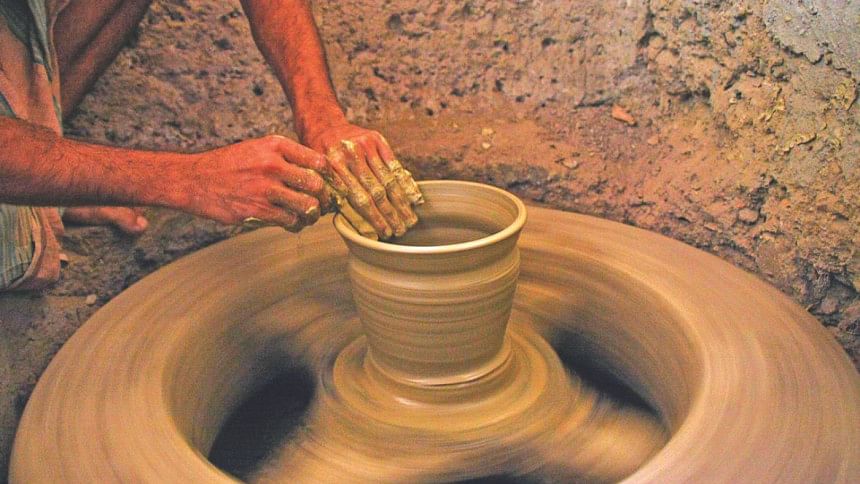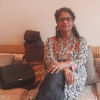The soul in enduring clay

The earth rotates on its axis. The seasons change, and my soul throbs to the rhythm of the Bengal delta. The elements of air, water, earth, and fire call out to me with the first whiff of the Bengali New Year. As I yearn for release from the sweltering Chaitra heat, the month of Baishakh beckons with low, growling thunder and the distant, jagged flash of silver lightning. I look up at the wide, blue-black canopy of the sky for the tumultuous harbinger of Pahela Baishakh, the heavenly benediction in the form of the approaching Kalboishaki. My trembling body anticipates the glorious delight of the gift of dark cumulous clouds carrying florets of drenching rain, and my long tresses float in the wild stream of the furious nor'wester. The howling treetops surrender their weak and dead limbs in the wake of the storm's epic sweep, and Bengal reverberates to the song of renewal and rebirth.
I hear the red soil of Bengal ripple with the tangible, audible cry of the Kalboishaki. Pellets of hailstones hit thatched and tiled and corrugated tin roofs, and the sodden ground turns into a field of snaky, muddy rivulets. Nature energises the blood, and the village folk shake their lethargy to embrace laughter and productive labour. Mother-earth calls, 'Daub your huts with warm, wet clay, scour your earthen pots and pans with fistfuls of squelching alluvial mud, slake your sun-burnt, parched skins by soaking in the bold rainfall. Inhale the smoky, intoxicating fumes of damp, native clay, and know your homestead. Till the field, and plant the paddy, and stand at sundown to gaze lovingly at the glistening horizon. Settle accounts, pay your debts, close the tattered cover of the old year's ledger, and welcome the New Year with the ritual opening of a pristine red Halkhata.'

Woefully, for me, this Pahela Baishakh, on April 14 2016, in the New Year 1423 of the Bengali calendar, my Halkhata will begin with the record of eternal parting. On Pahela Baishakh, my beloved father's body would have been fused with native clay, having lain in his final resting place for eighteen days and nights. The Potter had finally finished moulding him on the Wheel of life. The time had come for the soul's vessel, vassal to the Almighty, to return to the place whence it came: “Time's wheel runs back or stops : Potter and clay endure.”
‘Endurance' is the master-narrative of Bengali folk. Flood and famine, and nature's other seasonal, violent vicissitudes, have made us resilient and resolute. The unique geography and climate of the delta have given us slight, lithe, lissome physiques. Fed since ancient times upon plentiful rice and fresh sweet-water fish, Bengali folk have not bred swarthy warriors,
but charmed travelers and temporary sojourners with arts and crafts. Potters and weavers and metalworkers and goldsmiths create dazzling, intricately-designed artifacts praised and highly prized by all who look upon them. Every harvest, or spring, autumn, and winter festival is a colourful carnival, with music and dance and ritual offerings and prayers. Each festival in Bengal is transformational; a symbolic, collective renewal of vows of bondage to red clay, a secular or communal expression of gratitude in the midst of recurring adversity. Every festival becomes a living, dynamic document of the soul's survival, an assertion of joyful commitment and continuity; a mela, boshonto mela, Baishakhi mela, rongomela.
Clay sculpture has dominated the visual culture of Bengal since the dawn of the Indus Valley civilisation. In the absence of other hard raw materials like rocks and stone, the porous red clay of the Lower Gangetic delta became the primary ingredient for making household cooking pots and storage urns, as well as for building bricks and roofing tiles. Fired and glazed pottery became the expertise of skilled artisans, while unfired, sun-baked clay objects were commodities of daily life. Clay figures, animal as well as anthropomorphic, and both votive and decorative images, have archeological, historically located origins. For example, the iconic Bankura horse has become representative of Bengali folk art, even as scholarly debate surrounds the topic of whether the horse was indigenous to Bengal or was brought here from Persia or Arabia. Clay has truly been called 'at once the most humble and the most exalted' among earth's raw materials. Indeed, while clay has been integral to the life of rural Bengal for centuries, modern times has seen the value of terra cotta art and pottery rise among urban dwellers. Especially before Pahela Baishakh, patronage of the work of communities of rural potters through open exhibitions of their artistic and more affordable household items encourages buyers to decorate their homes as well as stack their kitchen cabinets with urns and pots, clay mugs and cups, and bowls and platters for serving sumptuous Bengali cuisine. This new trend among the well-to-do in cities has revived a cottage industry which was on the verge of decline. It has made pottery once again a self-sustaining avocation for the poor, skilled kumar whose existence is threatened by the ubiquitous, cheap, non-bio-degradable plastic and melamine goods. Today, Bangladeshi pottery and high-end glazed or unglazed pieces are also prized export items.
For the average Bengali householder, certain food items are unimaginable unless they are set in clay bowls. First and foremost, especially in my home, Mishti doi (sweet curd), so much a part of Bengali hospitality, cannot be imagined without its clay bowl container. And, of course, we all know how drinking water remains cool in clay pitchers in our semi-tropical climate. Just as cotton fabric lets the skin breathe during the stifling hot weather, porous clay allows food items and fluids to retain their cool freshness. In fact, the rich earthy aroma of clay can enhance the pleasure felt in the tongue's taste-buds. Even today, I often hear how food cooked in baked clay utensils has a more satisfying earthy flavor, similar to the scent exuded by the smokiness cherished by aficionados of food cooked in wood-burning stoves.
Today, as I write about the earthiness of clay, about Bengal's 'soul' in enduring clay, the little girl that I once was comes alive in my memory. I remember with acute longing the few school holidays spent in our village in Dhamrai. I remember the fields of yellow mustard flowers, and the lush green paddy fields with the ribbed raised edges of earth upon which I walked foot by foot to gather the feathery tall wild grass. I remember the festive atmosphere in the open inner courtyard with mud-baked 'choolas' shooting smoke and flames, where the old grand-aunt, or her daughter and daughters-in-law sat on low wooden piris and cooked bhapa pitha, or chitoi pitha on wintry mornings. But, alas, those days are so far in the past that today my tongue is dry and cannot recreate the essence of that lost childhood palate.
Today, I feel I can understand the 'soul' of clay by enduring the pain of loss, by grappling with the travails of earthly strife. I find ample reward in inhaling the exuberance and the aroma of the rainfall on red clay in my front-yard. As I breathe in the fragrance of wet clay, memories of my long journey with my father beside me keeps me resolute and strong for the coming year. I await the Kalboishaki with calm fortitude.
The writer is Professor, Department of English, University of Dhaka.

 For all latest news, follow The Daily Star's Google News channel.
For all latest news, follow The Daily Star's Google News channel. 



Comments